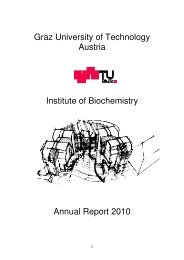Staff Members of the Institute of Biochemistry, TU - Institut für ...
Staff Members of the Institute of Biochemistry, TU - Institut für ...
Staff Members of the Institute of Biochemistry, TU - Institut für ...
You also want an ePaper? Increase the reach of your titles
YUMPU automatically turns print PDFs into web optimized ePapers that Google loves.
Organelle association and membrane contact between organelles (Fig. 1) may be a relevant<br />
mechanism for lipid transport between organelles, but components governing this process<br />
and related events have to be studied in future investigations.<br />
Growth <strong>of</strong> yeast on oleic acid not only induces formation <strong>of</strong> peroxisomes, but also leads to an<br />
intense syn<strong>the</strong>sis <strong>of</strong> triacylglycerols which are stored in lipid particles (see below). The link<br />
between neutral lipid metabolism and peroxisome proliferation is subject to current<br />
investigations with emphasis on <strong>the</strong> role <strong>of</strong> enzymes involved. These studied are related to<br />
<strong>the</strong> possible lipotoxic effect <strong>of</strong> fatty acids in yeast. Most recently we also studied <strong>the</strong> link<br />
between PE metabolism and neutral lipid storage. For this purpose we analyzed lipids from<br />
strains bearing defects in PE syn<strong>the</strong>sis. These analyses showed that a mutant bearing a defect<br />
in <strong>the</strong> CDP-ethanolamine pathway had a decreased level <strong>of</strong> triacylglycerols (TAG). The<br />
molecular reason for this finding is currently under investigation.<br />
Neutral lipid storage in lipid particles and mobilization<br />
Yeast cells have <strong>the</strong> capacity to store neutral lipids TAG and STE (steryl esters) in subcellular<br />
structures named lipid particles/droplets. Upon requirement, TAG and STE can be mobilized<br />
and serve as building blocks for membrane biosyn<strong>the</strong>sis. In an ongoing project <strong>of</strong> our<br />
laboratory, we focused on <strong>the</strong> characterization <strong>of</strong> enzymatic steps which lead to <strong>the</strong><br />
mobilization <strong>of</strong> TAG and STE depots.<br />
In Saccharomyces cerevisiae, <strong>the</strong> three STE hydrolases Tgl1p, Yeh1p and Yeh2p contribute<br />
differently to STE mobilization from <strong>the</strong>ir site <strong>of</strong> storage, <strong>the</strong> lipid particles. In a biochemical<br />
study we investigated enzymatic and cellular properties <strong>of</strong> <strong>the</strong>se three hydrolytic enzymes.<br />
Using <strong>the</strong> respective single, double and triple deletion mutants and strains overexpressing <strong>the</strong><br />
three enzymes, we demonstrated that each STE hydrolase exhibits certain substrate<br />
specificity. Interestingly, disturbance in STE mobilization also affects sterol biosyn<strong>the</strong>sis in a<br />
type <strong>of</strong> feedback regulation. We also showed that sterol intermediates stored in STE and set<br />
free by STE hydrolases are recycled to <strong>the</strong> sterol biosyn<strong>the</strong>tic pathway and converted to <strong>the</strong><br />
final product, ergosterol. This recycling implies that <strong>the</strong> vast majority <strong>of</strong> sterol precursors are<br />
transported from lipid particles to <strong>the</strong> ER where sterol biosyn<strong>the</strong>sis is completed. Ergosterol<br />
formed through this route is <strong>the</strong>n supplied to its subcellular destinations, especially <strong>the</strong> plasma<br />
membrane. Only a minor amount <strong>of</strong> sterol precursors set free from STE are randomly<br />
distributed within <strong>the</strong> cell after cleavage. In conclusion, STE storage and mobilization<br />
although dispensable for yeast viability contribute markedly to sterol homeostasis and<br />
distribution.<br />
A major focus <strong>of</strong> our neutral lipid project was <strong>the</strong> biochemical characterization <strong>of</strong> <strong>the</strong> three<br />
yeast TAG lipases, Tgl3p, Tgl4p and Tgl5p. Previous work from our laboratory had<br />
demonstrated that deletion <strong>of</strong> TGL3 encoding <strong>the</strong> major yeast TAG lipase resulted in<br />
decreased mobilization <strong>of</strong> TAG, a sporulation defect and a changed pattern <strong>of</strong> fatty acids,<br />
especially increased amounts <strong>of</strong> C22:0 and C26:0 very long chain fatty acids in <strong>the</strong> TAG<br />
fraction. To study a possible link between TAG lipolysis and membrane lipid biosyn<strong>the</strong>sis, we<br />
carried out biochemical experiments with wild type and deletion strains bearing defects in<br />
Tgl3p, Tgl4p and Tgl5p. We demonstrated that tgl mutants had a lower level <strong>of</strong> sphingolipids<br />
and glycerophospholipids than wild type. ESI-MS/MS analyses confirmed that TAG<br />
accumulation in <strong>the</strong>se mutant cells resulted in reduced amounts <strong>of</strong> phospholipids and<br />
sphingolipids. In vitro and in vivo experiments revealed that TAG lipolysis markedly affected<br />
17














